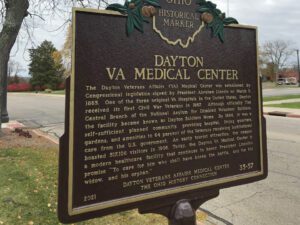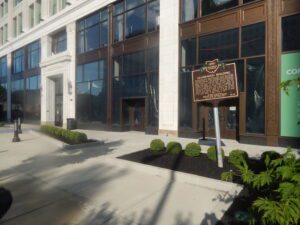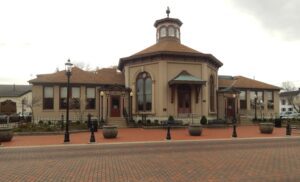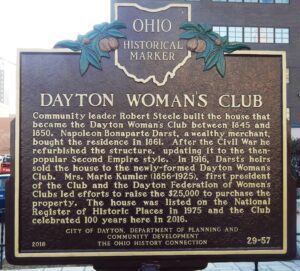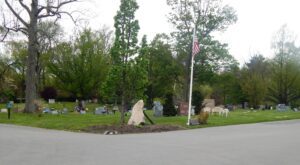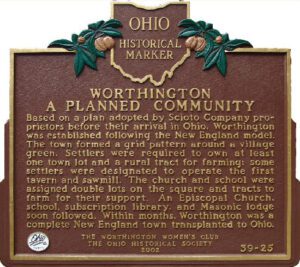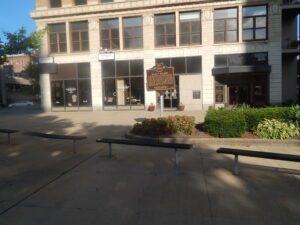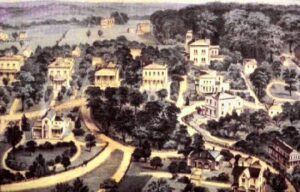, OH
The Dayton Veterans Affairs (VA) Medical Center was established by Congressional legislation signed by President Abraham Lincoln on March 3, 1865. One of the three original VA Hospitals in the United States, Dayton received its first Civil War Veterans in 1867. Although officially The Central Branch of the National Asylum for Disabled Volunteer Soldiers, the facility became known as Dayton Soldiers Home. By 1884, it was a self-sufficient planned community, providing hospital, living quarters, gardens, and amenities to 64 percent of the Veterans receiving institutional care from the U.S. government. An early tourist attraction, the campus boasted 517,106 visitors in 1906. Today, the Dayton VA Medical Center is a modern healthcare facility that continues to honor President Lincoln’s promise “To care for him who shall have borne the battle, and for his widow, and his orphan.”
, OH
Steel-frame skyscrapers and retail buildings replaced wood-frame residences as the downtown evolved into a commercial district. A small public library branch occupied the north side of the square from 1923 to 1954. The Keith-Albee Theater (later the Palace) in the northeast corner of the square from 1926 to 1964, featured vaudeville performances and movies. Streetcar tracks around the square were removed for scrap during World War II. With expansion of suburban shopping malls, downtown theaters and department stores gradually closed. In 1973-74 Central Square was converted to a pedestrian Federal Plaza by closing off traffic on Federal Street one block east and west of Market Street. Central Square reopened in 2004 with a new traffic pattern, planting beds, and street furniture. Marker for “Central Square (1798-1899)” across the street.
, OH
Clark Lane (1823-1907), industrialist and philanthropist, was a son of John Lane (1793-1880) and Rosanah Crum (1795-1877). John came with his family to the Ohio Country when it was still part of the Northwest Territory. As a young man, Clark worked in his family’s blacksmith shop, and eventually helped found Owens, Lane & Dyer Machine Company in 1854. It built agricultural machinery, sawmills, papermaking machines, and other products, initiating Hamilton’s prominence in metals manufacturing. Lane funded the Butler County Children’s Home, an orphanage for over a century, and constructed an octagon house as his residence on Third Street. He built this library in 1866, also as an octagon, and donated it to the people of Hamilton. A 19th century admirer wrote, “The name and generous deeds of Clark Lane will never fade from the memories of a grateful people who have been recipients of his favor.”
, OH
Dayton Woman’s Club. Community leader Robert Steele built the house that became the Dayton Woman’s Club between 1845 and 1850. Napoleon Bonaparte Darst, a wealthy merchant, bought the residence in 1861. After the Civil War he refurbished the structure, updating it to the then-popular Second Empire style. In 1916, Darst’s heirs sold the house to the newly-formed Dayton Woman’s Club. Mrs. Marie Kumler (1856-1925), first president of the Club and the Dayton Federation of Women’s Clubs led efforts to raise the $25,000 to purchase the property. The house was listed on the National Register of Historic Places in 1975 and the Club celebrated 100 years here in 2016.
, OH
Founded in 1876 by a group of Toledo businessmen, Woodlawn Cemetery was designed in the tradition of the country’s “rural cemetery” movement, which was first popularized in Europe in the 1830s. This movement reflects the change in American burial practices in the nineteenth century as attitudes of death changed from grim to sentimental. The cemetery’s landscape emphasizes nature and art. Besides being a burial place, the cemetery is an arboretum, bird sanctuary, outdoor museum, and historical archive. Woodlawn also became a fashionable park for Toledo’s residents to escape the commotion of the city. The cemetery chronicles the growth of Toledo and northwest Ohio, and is an important cultural and historic landmark in regards to community planning and development, and landscape and building architecture. Historic Woodlawn Cemetery was listed on the National Register of Historic Places in 1998.
, OH
The Scioto Company, led by James Kilbourn (Kilbourne) of Granby and Berlin, Connecticut, founded Worthington in 1803, the year that Ohio became a state. The Scioto Company was organized as a land company in 1802 with 38 original proprietors from Connecticut and Massachusetts. They purchased 16,000 acres of land along the Olentangy River for $1.25 per acre. The name Worthington was adopted in honor of Thomas Worthington, Territorial Land Commissioner, United States Senator, and future Ohio governor. He advised Kilbourn on the location for the settlement and his name provided recognition for the community.
, OH
The figure atop the Soldiers’ Monument has looked over Youngstown’s Central Square since 1870. Ohio Governor David Tod began campaigning for a monument for Youngstown’s fallen soldiers even before the Civil War ended. The community raised $15,000, and the cornerstone was laid in 1868. The memorial was completed and dedicated on July 4, 1870, with Governor Rutherford B. Hayes and Congressman James A. Garfield, both future U.S. presidents, attending the ceremony. Four cannons procured by Garfield formerly surrounded the monument. In 1951 the figure on the pedestal was accidentally damaged. A new statue of Carrara marble was commissioned, sculpted in Italy, and installed in 1955. The Bertolini Bros., a local marble firm, donated the new figure, which as patterned after the original, as their gift to the city.
, OH
Established in 1851 after the addition of the Cincinnati, Hamilton, and Dayton Railway, Glendale incorporated in 1855 as Ohio’s first planned community and one of the nation’s first planned villages. The original planning included forested greenbelts and parks, curvilinear streets meandering around established trees, large lots, and superior building standards. Glendale is designated as a National Historic Landmark community from the Department of Interior and a Certified Local Government through the Ohio Historic Preservation Office, all owed to Glendale’s persistent adherence to the plan and faithful preservation of original infrastructure. Much of today’s preserved infrastructure includes the original 59 pivotal buildings, curvilinear streets, tree canopy, stone gutters, gas streetlights, and railroad depot.


